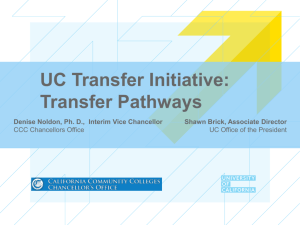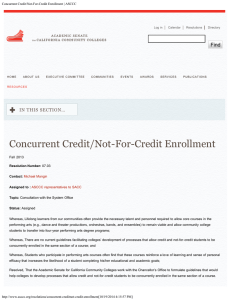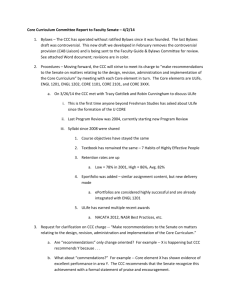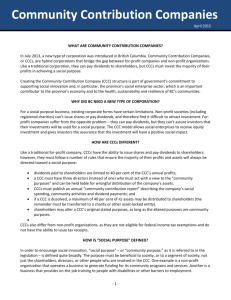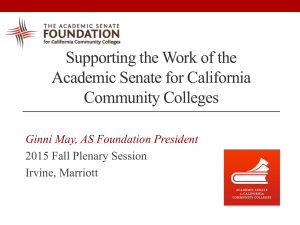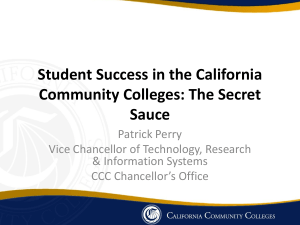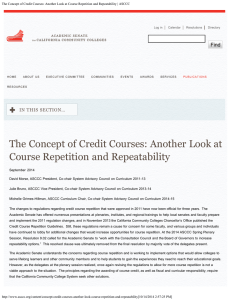Is it time for an Academic senate makeover?
advertisement
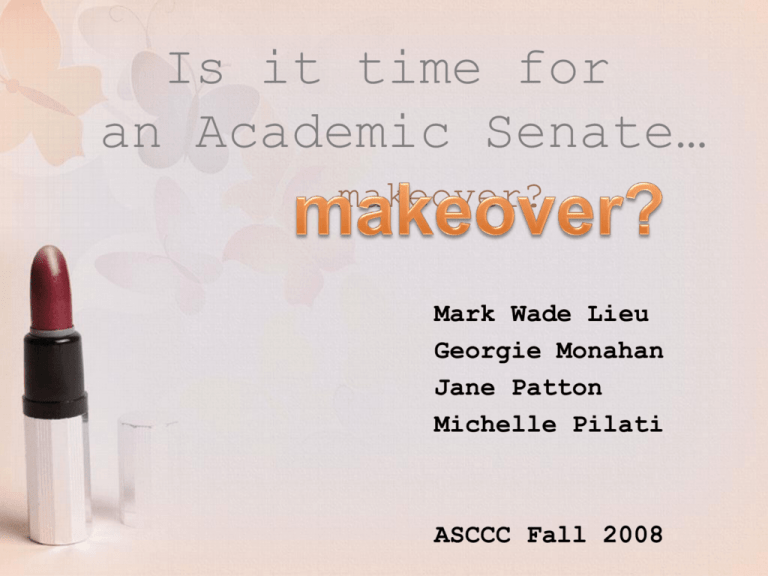
Is it time for an Academic Senate… makeover? Mark Wade Lieu Georgie Monahan Jane Patton Michelle Pilati ASCCC Fall 2008 WHY? • Other groups sponsored discussions • Changes in our colleges • Changes in Academic Senate • Our relationships have expanded • ASCCC began in 1969. . . Fashion Changes PLANS • ASCCC discussions (Futures committee & Exec) • Your input • Consultant-facilitated visioning session PLANS • Work with advertising consultant • Work with our designer • Make changes ELEMENTS INCLUDE. . . • Tag phrase (“elevator phrase”) • Logo; “corporate” signature (look & identity) • Website • Colors • Standards manual • Other? OUR MISSION The Academic Senate for California Community Colleges fosters the effective participation by community college faculty in all statewide and local academic and professional matters; develops, promotes, and acts upon policies responding to statewide concerns; and serves as the official voice of the faculty of California Community Colleges in academic and professional matters. The Academic Senate strengthens and supports the local senates of all California community colleges. CONSIDERATIONS • Audiences – Internal (e.g. faculty, administrators, System Office) – External (e.g. public, CSU/UC, legislature) • Should we aim to go green? • Others? DISCUSSION 1 How do you see the ASCCC? Who are we? 2 How do others see the ASCCC? (internal & external groups) 3 What do we communicate well about who we are? 4 What might we improve upon? Where are opportunities for improvement? 5 What message should be conveyed simply in a tag phrase? What’s our core yet easily-understood message? (our “brand”) 6 Discuss ideas for website; logo; others. WHO ARE WE? • 10 + 1 • And. . . "The teacher in an institution of higher learning is an officer of the corporation. . . and not an employee or hired person in the usual sense. To misconceive the basic nature and role of the college or university faculty member threatens the whole concept and function of the higher learning. . . . The college or university is fundamentally different from business, military or governmental organizations.” Principles & Values for College & University Administrators, by Pulias & Wilbur, 1984 “This point is extremely complex and very difficult to make clear, yet on its acceptance may hang the welfare and perhaps even the survival of institutions of higher learning. ...the individual faculty member is a self respecting officer of the organization who after proper evaluation by senior members of the community becomes a permanent part of the organization.” Principles & Values for College & University Administrators, by Pulias & Wilbur, 1984 A Brand for California Community Colleges? • Research (Neiman & Gould) says people like: – CCCs overall – CCCs as a solution – Universal access & opportunity • Research: – We’re defensive; project “can’t do” attitude – We’re not united around common purpose • Public does not see us as a system (and we are not one) • Issue: autonomous districts/colleges (ergo resistance to being part of system). – Benefits to conveying a system image (Prop 92; legislation) SAMPLE TAG LINES. . . • CCC’s are an ideal solution that provides access, opportunity & upward mobility • CCC’s: affordable, flexible. • CCC: how you move up in the world (then under it you can add local messages) • CCC: the opportunity of a lifetime. (then under it you can add local messages) • CCC: we’re going to take you higher. • “Start here go anywhere” is used at Alan Hancock DISCUSSION 1 What is our niche as CCCs? How are we unique?(Researchers’ advice: don’t compare to universities) 2 What might be a universal, over-arching “brand” for CCCs that local districts can adapt & use? What should the CCC message be? (advice: focus on transfer & CTE) 3 Would colleges be willing to adopt a state “brand” and have a local and compatible one? (What are barriers?) The beginning. . .



